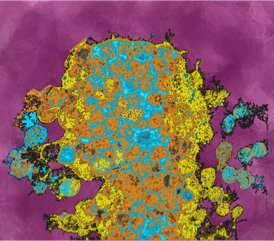Cell contacts in embryonic development determine cellular fate

The average human has about 37.2 trillion cells. But cells are differentiated for thousands of different functions. How does a cell 'know' which function to fulfill? In a paper published today in Developmental Cell, the group of Carl-Philipp Heisenberg at the Institute of Science and Technology Austria (IST Austria), including first author and Ph.D. student Vanessa Barone, sheds light on how a cell's fate is determined. Ffor the first time, they report a positive feedback loop between the duration of cell-cell contacts and the specification of a cell's function.
Cells do not just sit passively alongside each other. Instead, neighbouring cells can form contacts with each other—connections of different size, strength and duration that reach from one cell to another. Heisenberg and his group used the zebrafish to investigate whether signaling between cells and cell-cell contact formation affect each other, and influence how a cell's fate is determined.
The researchers looked at progenitor cells within the forming anterior axial mesendoderm that give rise to either the head mesoderm or endoderm of the developing embryo. In this system, the authors identified a positive feedback loop between cell-cell contact formation and cell fate specification: when mesendoderm progenitor cells form long-lasting cell-cell contacts, they become head mesoderm cell types, while short-lasting contacts result in endoderm cell types.
Cell-cell contact formation and cell fate specification promote each other by contact formation triggering high Nodal/TGFβ-mediated cell-cell signaling, required for head mesoderm cell fate specification and differentiation; nodal signaling, in turn, promotes cell-cell contact formation. The authors thereby identified cell-cell contact duration (as opposed to e.g. the number or size of cell-cell contacts) as a key feature in controlling the level of cell-cell signaling determining binary cell fate decisions during embryonic development.
More information: Developmental Cell (2017). DOI: 10.1016/j.devcel.2017.09.014
Journal information: Developmental Cell
Provided by Institute of Science and Technology Austria





















